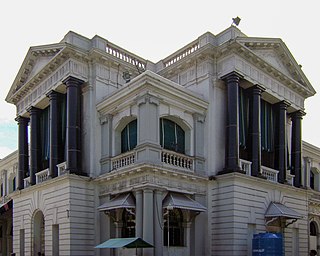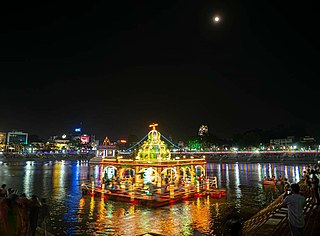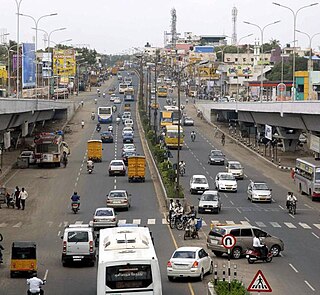
Fort St. George is the first English fortress in India, founded in 1639 at the coastal city of Madras, the modern city of Chennai. The construction of the fort provided the impetus for further settlements and trading activity, in what was originally an uninhabited land. Thus, it is a feasible contention to say that the city evolved around the fortress. The fort currently houses the Tamil Nadu legislative assembly and other official buildings.

Mylapore is a neighborhood in the central part of the city of Chennai, India. It is one of the oldest residential parts of the city. It is also called Thirumayilai. The locality is claimed to be the birthplace of the celebrated Tamil philosopher Valluvar.

Chromepet is a suburban neighbourhood of Chennai, India. Located in the southern Chennai Metropolitan Area, it is governed by the Tambaram Municipal Corporation. Chromepet is located 22 km from the Chennai Central Railway Station, and lies on the Grand Southern Trunk, close to Thirumudivakkam and Tambaram, and next to Pallavaram. The 200-feet road connects Chromepet with Thoraipakkam. Chromepet is 6 km from Outer Ring Road, Thirumudivakkam, and 4 km south of the Chennai International Airport at Trisulam.

Parangi Malai is a small hillock in Chennai, Tamil Nadu, India, near the neighbourhood of Guindy and very close to Chennai International Airport.

Saidapet, also known as Saidai, is a neighbourhood in Chennai, India, situated in the northern banks of the Adyar River and serves as an entry point to Central Chennai. It is surrounded by West Mambalam in the North, C.I.T Nagar in the North-East, Nandanam in the East, Guindy in the South, Jafferkhanpet and Ashok Nagar in the North-West. The Saidapet Court, the only other court of judicature in Chennai city apart from the Madras High Court, and the Saidapet bus depot are located here. Prior to its incorporation in Madras city, Saidapet functioned as the administrative headquarters of Chingleput district. The neighbourhood is served by Saidapet railway station of the Chennai Suburban Railway Network.

Meenambakkam is a southern neighbourhood of Chennai in the Indian state of Tamil Nadu. It is home to Chennai International Airport, the Airports Authority of India regional office, and the DGQA Complex. It was under the reign of the Pallava kingdom. The name Meenambakkam signifies that it is a settlement near the coast. Pakkam means a settlement near to the coast. Meenambakkam was cherished with lakes, ponds and borderlines the Adyar river. This makes it a rich source of fishes. Hence the name Meenambakkam was coined.

Pallavaram is a residential neighborhood of Chennai, India. Pallavaram was a part of Alandur until August 2015 and since then a new taluk with headquarters at Pallavaram was created. The neighbourhood is known for its cantonment and bustling residential colonies and is served by Pallavaram railway station of the Chennai Suburban Railway Network.

Poonamallee is a neighbourhood in the west of Chennai, India. It is a town in the Poonamallee taluk of the Tiruvallur district in the Indian state of Tamil Nadu. The nearest Railway station is at Thiruninravur. It acts as the gateway to the city from its western side. It is a town with rich cultural heritage and also a fast-growing areas in the city. As of 2011, the town had a population of 57,224. There are plans to merge the areas under Poonamallee Municipality with Avadi Municipal Corporation.

Nandambakkam is a western neighbourhood of Chennai, India. It is known for the Chennai Trade Centre and the Surgical Instruments Factory. In 2011 Nandambakkam was included to Chennai district by the Government of Tamil Nadu.

San Thome Church, is known as St. Thomas Cathedral Basilica and National Shrine of Saint Thomas, is a Roman Catholic minor basilica in the Santhome neighbourhood of the city of Madras (Chennai), in Tamil Nadu, India. The present structure dates to 1523 AD, when it was built by the Portuguese, over the tomb of Thomas the Apostle, one of the apostles of Jesus. In 1896, it was rebuilt in British Madras according to Neo-Gothic style, as was favoured by British architects in the late 19th century. This church is one of the three known churches in the world built over the tomb of an apostle of Jesus that are still standing today, the other two being St Peter's Basilica in Vatican City and Santiago de Compostela Cathedral in Galicia, Spain. In antiquity, there was a basilica built over the tomb of the Apostle Philip in Hierapolis of Phrygia, near modern day Pamukkale.

Santhome is a locality in Mylapore in Chennai city in India.

Anna Salai, formerly known as St. Thomas Mount Road or simply Mount Road, is an arterial road in Chennai, India. It starts at the Cooum Creek, south of Fort St George, leading in a south-westerly direction towards St. Thomas Mount, and ends at the Kathipara Junction in Guindy. Beyond the Kathipara Junction, a branch road arises traversing westwards to Poonamallee to form the Mount-Poonamallee Road while the main branch continuing southwards to Chennai Airport, Tambaram and beyond to form Grand Southern Trunk Road. Anna Salai, which is more than 400 years old, is acknowledged as the most important road in Chennai city. The head offices of many commercial enterprises and public buildings are located along Anna Salai. It is the second longest road in Chennai, after EVR Periyar Salai.

Church of Our Lady of Light is a Roman Catholic shrine in Chennai, India. It is commonly called as Luz Church by the locals, which derives from the Portuguese name Nossa Senhora da Luz. Built in 1516 by the Portuguese, it is one of the oldest Churches in the city and its foundation stone marks as one of the oldest European monuments in India. The history of the church dates back to the 16th-century legend of safe arrival to land by missionaries. The church is located very near to the Santhome Basilica, where Apostle Thomas is believed to be buried.

St. Andrew's Church in Egmore, Chennai, India was built to serve the Scottish community in Chennai. Building started 6 April 1818 and the church was consecrated in 1821. It is one of the oldest churches in Madras. Its design was modelled on St Martin-in-the-Fields and along with St. George's Church, Dublin, it is considered one of the finest stylistic "daughter" churches to the famous Trafalgar Square structure.

Charnockite, St. Thomas Mount, located to the south of the Chennai city, in Pallavaram suburb, Tamil Nadu, is a characteristically profuse exposure of quartz–feldspar–hypersthene rock, illustrated by occurrence of two pyroxene facies metamorphism.

Christianity in the state of Tamil Nadu, India is the second largest religion in the state. According to tradition, St. Thomas, one of the twelve apostles, landed in Malabar Coast in AD 52. In the colonial age many Portuguese, Dutch, British and Italian Christians came to Tamil Nadu. Priests accompanied them not only to minister the colonisers but also to spread the Christian faith among the non-Christians in Tamil Nadu. Currently, Christians are a minority community comprising 6% of the total population. Christians are mainly concentrated in the southern districts of Tamil Nadu - Kanyakumari, Thoothukudi and Tirunelveli.

Armenian Street, locally known as Aranmanaikaran Street, is one of the historical streets of the commercial centre of George Town in Chennai, India. The road runs north–south and connects Mannady Street in the north with the China Bazaar Road in the south. The street is dotted with several century-old historical structures.
V. Balan, popularly known as Artist V. Balan, was a sculptor and painter from India. He was born the son of Chellamma and Venketachelam Pillai in the small temple town of Perumbavoor, Kerala. In 1962 he earned a Diploma from the Cochin School of Art. Immediately after his studies, he started teaching at the same school. In 1970 he moved to Chennai as a freelance artist.
Chennai is religiously cosmopolitan, with its denizens following various religions, chief among them being Hinduism, Islam, Christianity, Sikhism, Jainism, Buddhism, and Zoroastrianism. Chennai, along with Mumbai, Delhi, Kochi, and Kolkata, is one of the few Indian cities that are home to a diverse population of ethno-religious communities. With the majority of the people in India following Hinduism, Chennai, like other Indian cities, is home to more Hindus than any other religion. Chennai has centres of worship for a multitude of faiths. According to 2001 census, majority of the population are Hindus, Muslims, Christians, Jains, Sikhs, and Buddhists.


















